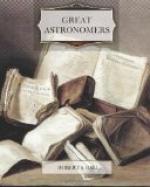Having thus gained an independent position, Airy immediately entered upon that career of scientific work which he prosecuted without intermission almost to the very close of his life. One of his most interesting researches in these early days is on the subject of Astigmatism, which defect he had discovered in his own eyes. His investigations led him to suggest a means of correcting this defect by using a pair of spectacles with lenses so shaped as to counteract the derangement which the astigmatic eye impressed upon the rays of light. His researches on this subject were of a very complete character, and the principles he laid down are to the present day practically employed by oculists in the treatment of this malformation.
On the 7th of December, 1826, Airy was elected to the Lucasian Professorship of Mathematics in the University of Cambridge, the chair which Newton’s occupancy had rendered so illustrious. His tenure of this office only lasted for two years, when he exchanged it for the Plumian Professorship. The attraction which led him to desire this change is doubtless to be found in the circumstance that the Plumian Professorship of Astronomy carried with it at that time the appointment of director of the new astronomical observatory, the origin of which must now be described.
Those most interested in the scientific side of University life decided in 1820 that it would be proper to found an astronomical observatory at Cambridge. Donations were accordingly sought for this purpose, and upwards of 6,000 pounds were contributed by members of the University and the public. To this sum 5,000 pounds were added by a grant from the University chest, and in 1824 further sums amounting altogether to 7,115 pounds were given by the University for the same object. The regulations as to the administration of the new observatory placed it under the management of the Plumian Professor, who was to be provided with two assistants. Their duties were to consist in making meridian observations of the sun, moon, and the stars, and the observations made each year were to be printed and published. The observatory was also to be used in the educational work of the University, for it was arranged that smaller instruments were to be provided by which students could be instructed in the practical art of making astronomical observations.
The building of the Cambridge Astronomical Observatory was completed in 1824, but in 1828, when Airy entered on the discharge of his duties as Director, the establishment was still far from completion, in so far as its organisation was concerned. Airy commenced his work so energetically that in the next year after his appointment he was able to publish the first volume of “Cambridge Astronomical Observations,” notwithstanding that every part of the work, from the making of observations to the revising of the proof-sheets, had to be done by himself.




